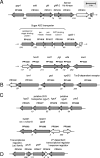Convergent peripheral pathways catalyze initial glucose catabolism in Pseudomonas putida: genomic and flux analysis
- PMID: 17483213
- PMCID: PMC1951859
- DOI: 10.1128/JB.00203-07
Convergent peripheral pathways catalyze initial glucose catabolism in Pseudomonas putida: genomic and flux analysis
Abstract
In this study, we show that glucose catabolism in Pseudomonas putida occurs through the simultaneous operation of three pathways that converge at the level of 6-phosphogluconate, which is metabolized by the Edd and Eda Entner/Doudoroff enzymes to central metabolites. When glucose enters the periplasmic space through specific OprB porins, it can either be internalized into the cytoplasm or be oxidized to gluconate. Glucose is transported to the cytoplasm in a process mediated by an ABC uptake system encoded by open reading frames PP1015 to PP1018 and is then phosphorylated by glucokinase (encoded by the glk gene) and converted by glucose-6-phosphate dehydrogenase (encoded by the zwf genes) to 6-phosphogluconate. Gluconate in the periplasm can be transported into the cytoplasm and subsequently phosphorylated by gluconokinase to 6-phosphogluconate or oxidized to 2-ketogluconate, which is transported to the cytoplasm, and subsequently phosphorylated and reduced to 6-phosphogluconate. In the wild-type strain, glucose was consumed at a rate of around 6 mmol g(-1) h(-1), which allowed a growth rate of 0.58 h(-1) and a biomass yield of 0.44 g/g carbon used. Flux analysis of (13)C-labeled glucose revealed that, in the Krebs cycle, most of the oxalacetate fraction was produced by the pyruvate shunt rather than by the direct oxidation of malate by malate dehydrogenase. Enzymatic and microarray assays revealed that the enzymes, regulators, and transport systems of the three peripheral glucose pathways were induced in response to glucose in the outer medium. We generated a series of isogenic mutants in one or more of the steps of all three pathways and found that, although all three functioned simultaneously, the glucokinase pathway and the 2-ketogluconate loop were quantitatively more important than the direct phosphorylation of gluconate. In physical terms, glucose catabolism genes were organized in a series of clusters scattered along the chromosome. Within each of the clusters, genes encoding porins, transporters, enzymes, and regulators formed operons, suggesting that genes in each cluster coevolved. The glk gene encoding glucokinase was located in an operon with the edd gene, whereas the zwf-1 gene, encoding glucose-6-phosphate dehydrogenase, formed an operon with the eda gene. Therefore, the enzymes of the glucokinase pathway and those of the Entner-Doudoroff pathway are physically linked and induced simultaneously. It can therefore be concluded that the glucokinase pathway is a sine qua non condition for P. putida to grow with glucose.
Figures




Similar articles
-
A set of activators and repressors control peripheral glucose pathways in Pseudomonas putida to yield a common central intermediate.J Bacteriol. 2008 Apr;190(7):2331-9. doi: 10.1128/JB.01726-07. Epub 2008 Feb 1. J Bacteriol. 2008. PMID: 18245293 Free PMC article.
-
Simultaneous catabolite repression between glucose and toluene metabolism in Pseudomonas putida is channeled through different signaling pathways.J Bacteriol. 2007 Sep;189(18):6602-10. doi: 10.1128/JB.00679-07. Epub 2007 Jul 6. J Bacteriol. 2007. PMID: 17616587 Free PMC article.
-
Compartmentalized glucose metabolism in Pseudomonas putida is controlled by the PtxS repressor.J Bacteriol. 2010 Sep;192(17):4357-66. doi: 10.1128/JB.00520-10. Epub 2010 Jun 25. J Bacteriol. 2010. PMID: 20581202 Free PMC article.
-
Genetic evidence that catabolites of the Entner-Doudoroff pathway signal C source repression of the sigma54 Pu promoter of Pseudomonas putida.J Bacteriol. 2004 Dec;186(24):8267-75. doi: 10.1128/JB.186.24.8267-8275.2004. J Bacteriol. 2004. PMID: 15576775 Free PMC article.
-
Glucose Transport in Escherichia coli: From Basics to Transport Engineering.Microorganisms. 2023 Jun 15;11(6):1588. doi: 10.3390/microorganisms11061588. Microorganisms. 2023. PMID: 37375089 Free PMC article. Review.
Cited by
-
Genome reduction boosts heterologous gene expression in Pseudomonas putida.Microb Cell Fact. 2015 Feb 21;14:23. doi: 10.1186/s12934-015-0207-7. Microb Cell Fact. 2015. PMID: 25890048 Free PMC article.
-
Enhancing 2-Ketogluconate Production of Pseudomonas plecoglossicida JUIM01 by Maintaining the Carbon Catabolite Repression of 2-Ketogluconate Metabolism.Molecules. 2018 Oct 13;23(10):2629. doi: 10.3390/molecules23102629. Molecules. 2018. PMID: 30322137 Free PMC article.
-
Engineering Pseudomonas putida S12 for efficient utilization of D-xylose and L-arabinose.Appl Environ Microbiol. 2008 Aug;74(16):5031-7. doi: 10.1128/AEM.00924-08. Epub 2008 Jun 27. Appl Environ Microbiol. 2008. PMID: 18586973 Free PMC article.
-
Reconciling in vivo and in silico key biological parameters of Pseudomonas putida KT2440 during growth on glucose under carbon-limited condition.BMC Biotechnol. 2013 Oct 29;13:93. doi: 10.1186/1472-6750-13-93. BMC Biotechnol. 2013. PMID: 24168623 Free PMC article.
-
Transcriptional control by two interacting regulatory proteins: identification of the PtxS binding site at PtxR.Nucleic Acids Res. 2013 Dec;41(22):10150-6. doi: 10.1093/nar/gkt773. Epub 2013 Sep 9. Nucleic Acids Res. 2013. PMID: 24019239 Free PMC article.
References
-
- Ausubel, F. M., R. Brent, R. E. Kingston, D. D. Moore, J. G. Seidman, J. A. Smith, and K. Struhl (ed.) 2006. Current protocols in molecular biology. John Wiley & Sons, New York, NY.
-
- Barber, D. A., and J. K. Martin. 1976. The release of organic substances by cereal roots into the soil. New Phytol. 76:68-80.
-
- Brazma, A., P. Hingamp, J. Quackenbush, G. Sherlock, P. Spellman, et al. 2001. Minimum information about a microarray experiment (MIAME)—toward standards for microarray data. Nat. Genet. 29:365-371. - PubMed
-
- Dauner, M., and U. Sauer. 2000. GC-MS analysis of amino acids rapidly provides rich information for isotopomer balancing. Biotechnol. Prog. 16:642-649. - PubMed
Publication types
MeSH terms
Substances
LinkOut - more resources
Full Text Sources
Other Literature Sources
Molecular Biology Databases

